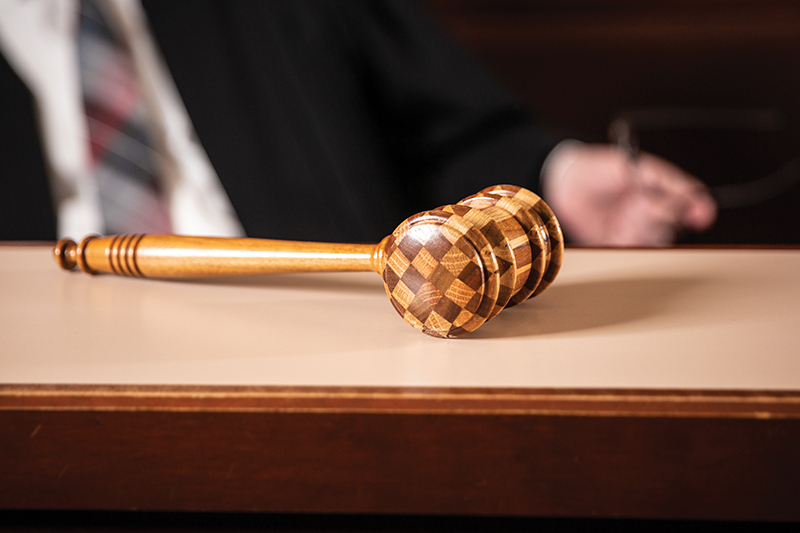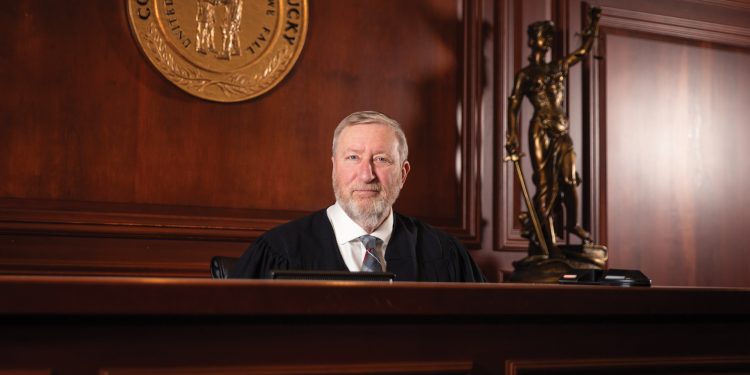Judge Joe Castlen, Division II Daviess County Circuit Court Judge, has had it in his plan for as long as he can remember to retire at the age of 70. However, 70 came and went in May of 2018, and Judge Castlen continued on.
But, after the sudden death of a close family member, and the encouragement of his wife, Castlen felt it best to follow through with his original plan. While his official retirement date is January 21, Castlen will remain on the bench until a replacement is elected or appointed. Although the ending of Castlen’s career appears to be getting the most attention, it’s the inspiration for its beginning that is even more interesting.
Born the second of seven children and the oldest of six boys—three of which (including himself) went on to practice law and become Circuit Judges—one might have reason to believe that law is in the Castlens’ blood. While Joe Castlen says his brothers may not be able to offer an explanation as to why they went into law, he feels strongly that he understands his reasoning.
“I think the reason I went into law and the reason they did is because of our brother Mikey,” Joe Castlen said. “Mikey was born in November 1953, and was classified as profoundly mentally retarded and had Down syndrome as well.”
Castlen said when Mikey was younger, the only state institution that provided care for children with disabilities offered a concrete floor with a trough down the center where residents would be washed off with a hose. He said his parents would not stand for that type of treatment or care of their child, so they soon joined with other parents in founding what is now referred to as The Arc of Owensboro/Opportunity Center, Inc.
“People would come in from out of town and talk around the dinner table. We were immersed in their struggle,” Castlen said, adding that those visits may have helped him and his brothers recognize the need for change and the necessity to struggle for the rights of other people.
That is not the only struggle Castlen keeps on the forefront. Hanging on the wall that leads from his chambers to the courtroom, Castlen has a large picture of Ruby Bridges displayed. Bridges, a civil rights activist, was the first African-American child to desegregate the all-white William Frantz Elementary School in Louisiana. That image has become more than just a moment in history to him, and more of a reminder that each day he is fighting for someone and something of importance.
“Every time I walk out I see that,” Castlen said. “That to me is the most important picture I’ve ever had.”

Upon entering the courtroom, Judge Castlen is surrounded by vivid portraits that serve as reminders of those that have come before him. A natural storyteller himself, Castlen shared how Lucius Little talked the bar into adopting paintings of all the judges in 1905. He said this practice continued and they had most all of the judges until 1962, when Castlen said they tore down the old courthouse and the paintings “disappeared,” and were reportedly given away.
What is most fascinating about the judges’ portraits is that the majority of the paintings or details in the framing were designed or created by several of the judges themselves. As the portraits wrap around the courtroom, one of the more recent paintings is of Judge Castlen’s younger brother, Tom. “I was in private practice over 23 years before I went on the bench,” Castlen said. “We were always going to practice together and never did.”
While Castlen says he wishes he had the opportunity to practice with his brother, as he feels strongly that they would have enjoyed the experience, he said private practice was both time-consuming and “intense.”
“Private practice will wear you out,” Castlen said. “I had three heart attacks and open heart surgery after I became a judge, but it was because of private practice,” he said with a laugh.
Although Castlen was not able to go into private practice with his brother, they did try cases at the same time, and he also had the opportunity to take over for Tom as Circuit Judge in 2008.
Between his 23-year career in private practice and his time on the bench as both District and Circuit Judge, Castlen has seen a world of change. He described in detail the many uses of the in-chamber microphone he now uses to hold private meetings, on the record telephonic conferences, and to protect the privacy of children in sensitive cases. But Castlen can still recall a time before there were microphones in chambers or courtrooms.
“It’s a change from when we first started practicing—we used to use stenographers.” Castlen described the infamous murder trial of Jesse and Roger Gentry, which was also the first time he was in a courtroom with microphones. He laughed to himself as he was able to recall some of the things uttered aloud by him and his brother Tom without realizing the microphone was present. Castlen has also watched as technology has changed everything from the way court documentation is taken to the way warrants are filed electronically.
Regardless of the changes that have taken place over the years, Castlen has stood by his desire to struggle for the rights of others, and work hard to make a difference, whether it is in teen court, juvenile drug court, or in criminal cases. As to the future of law and the court system in Daviess County and what it holds, Castlen is optimistic.
“We have incredible talent in the young people in our bar. It’s amazing. They are much better than we were—so much sharper,” Castlen said. “It’s not just the bar—here in town, we have an amazing group of young people in finance, in business and accounting.”
As Castlen looks at his own future, where he plans to travel with his wife, spend time with his grandchildren, and further explore his hobby of painting through online lessons, he won’t be leaving the world of law completely behind.
“I’d like to drive around to different counties and dig up these old stories. I had started a book for the lawyers to give them some flavor to their profession, make it a little more enjoyable perhaps—make a little more cohesive bar,” Castlen said. “When I first joined, we were just one big family. Practice has changed so much—I’d like to write that book.”










